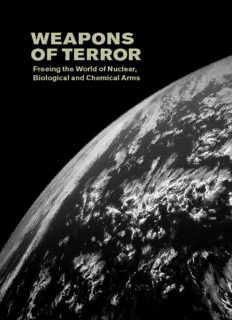
Weapons of Terror - Freeing the World of Nuclear, Biological and Chemical Arms PDF
Preview Weapons of Terror - Freeing the World of Nuclear, Biological and Chemical Arms
WEAPONS OF TERROR Freeing the World of Nuclear, Biological and Chemical Arms WMDC Commissioners Hans Blix, Chairman Dewi Fortuna Anwar Alexei G. Arbatov Marcos de Azambuja Alyson J.K. Bailes Jayantha Dhanapala Gareth Evans Patricia Lewis Masashi Nishihara William J. Perry Vasantha Raghavan Cheikh Sylla Prince El Hassan bin Talal Pan, Zhenqiang WEAPONS OF TERROR Freeing the World of Nuclear, Biological and Chemical Arms WEAPONS OF TERROR Freeing the World of Nuclear, Biological and Chemical Arms © 2006 Weapons of Mass Destruction Commission. All rights reserved. This publication may be reproduced in full or in part if accompanied with the following citation: Weapons of Mass Destruction Commission, final report, ‘Weapons of Terror: Freeing the World of Nuclear, Biological, and Chemical Arms’, Stockholm, Sweden, 1 june 2006. For electronic copies of this report, please visit www.wmdcommission.org. isbn: 91-38-22582-4 Printing: EO Grafiska, Stockholm Design: Fidelity Stockholm AB Photo: NASA/Roger Ressmeyer/Corbis Contents Abbreviations ....................................................................................8 Chairman’s preface ...........................................................................11 Synopsis ..........................................................................................17 Chapter 1. Reviving disarmament .....................................................21 Why weapons of mass destruction matter ............................................23 Disarmament in disarray ...................................................................24 The aim and approach of this report ...................................................26 Chapter 2. Weapons of terror: threats and responses ........................31 The nature of threats from weapons of mass destruction .......................32 Nuclear-weapon threats ..............................................................36 Biological-weapon threats ............................................................40 Chemical-weapon threats ............................................................42 Traditional responses to threats of weapons of mass destruction ............43 Unilateral responses ....................................................................44 Bilateral responses ......................................................................45 Plurilateral responses ..................................................................46 Regional responses ......................................................................47 Global responses .........................................................................48 Weaknesses in traditional responses ...................................................50 Lack of universality .....................................................................50 Withdrawal ................................................................................51 Inadequate verification ................................................................51 Non-compliance .........................................................................52 Lack of enforcement ....................................................................54 New responses to threats from weapons of terror .................................54 Counter-proliferation ..................................................................55 Three conclusions for collective action ................................................56 Chapter 3. Nuclear weapons .............................................................59 Preventing the proliferation of nuclear weapons ...................................62 The Non-Proliferation Treaty .......................................................62 Evolving treaty commitments .......................................................64 Cases of non-compliance .............................................................66 Security assurances .....................................................................72 The fuel cycle: controlling the production of enriched uranium and plutonium ............................................................................73 Fissile material clean-out .............................................................78 Regional issues and arrangements .................................................79 Preventing nuclear terrorism ..............................................................83 How could terrorists acquire nuclear weapons? ..............................83 Physical protection measures ........................................................85 Reducing the threat and the numbers of existing nuclear weapons ..........87 The need to re-examine and revise nuclear doctrines .......................88 Deployment of nuclear weapons ...................................................92 New limits on deployments of non-strategic nuclear weapons ..........95 Development of new nuclear weapons ...........................................98 Disposal of fissile material from warheads ......................................99 Ending production of weapons-usable fissile material: a fissile material cut-off treaty ......................................................103 Ending all nuclear-weapon tests: the Comprehensive Nuclear-Test-Ban Treaty ................................105 From regulating nuclear weapons to outlawing them ...........................108 Chapter 4. Biological and toxin weapons .........................................111 Prohibition of biological weapons ......................................................113 Prospects for the future ....................................................................115 Strengthening the role of the Convention ......................................115 National implementation ............................................................117 Institutional deficit .....................................................................119 Implementation of the Convention ...............................................119 Life sciences and the role of scientists ............................................121 Chapter 5. Chemical weapons .........................................................125 The Chemical Weapons Convention ..................................................127 Destroying the chemical-weapon stockpiles ..................................129 Promoting universality ...............................................................130 Non-lethal weapons, incapacitants and riot control agents ..............132 Enhancing the CWC’s inspection and monitoring capacity ..............134 Chemical terrorism ..........................................................................135 The threat of terrorist attacks against chemical industry .................135 Chapter 6. Delivery means, missile defences, and weapons in space .139 Means of WMD delivery ..................................................................140 Missile defences ............................................................................. 144 The weaponization of space ..............................................................146 Current status of the outer space security regime ...........................147 Chapter 7. Export controls, international assistance, and non-governmental actors ........................................................ 153 Export controls and other controls on the movement of goods ............. 154 Control of movement of goods .................................................... 154 International assistance for non-proliferation and disarmament ........... 155 Sectoral roles: business, research, voluntary organizations, and the public .................................................................................157 The responsibility of companies and the business sector .................157 The responsibility of scientists: codes of conduct ...........................158 Democratic control: role of representative institutions ....................159 Democratic control: NGOs and transparency ................................160 Public information and education ................................................161 Chapter 8. Compliance, verification, enforcement and the role of the United Nations ...................................................165 Compliance ....................................................................................168 Verification .....................................................................................169 Enforcement ...................................................................................175 The role of the United Nations ..........................................................177 The United Nations disarmament machinery ................................177 The role of the UN Security Council .............................................180 Beyond WMD .................................................................................183 Annex 1: WMDC recommendations .................................................188 Annex 2: Work of the Commission .................................................. 206 Mandate .................................................................................. 206 Commissioners’ biographies ...................................................... 209 Secretariat ................................................................................212 Financial and organizational support ..........................................212 Acknowledgements ...................................................................213 Sessions ...................................................................................214 Seminars and other public meetings .............................................215 Published WMDC studies ...........................................................217 Index ............................................................................................ 220 Abbreviations ABM Anti-ballistic missile ASAT Anti-satellite (weapon) BMD Ballistic missile defence BW Biological weapon/warfare BTWC Biological and Toxin Weapons Convention CBM Confidence-building measure CBW Chemical and biological weapons CD Conference on Disarmament CFE Conventional Armed Forces in Europe (Treaty) CTBT Comprehensive Nuclear-Test-Ban Treaty CTBTO Comprehensive Nuclear-Test-Ban Treaty Organization CTR Cooperative threat reduction CW Chemical weapon/warfare CWC Chemical Weapons Convention FAO Food and Agriculture Organization FMCT Fissile material cut-off treaty G8 Group of Eight, group of eight leading industrialized states GTRI Global Threat Reduction Initiative HCOC Hague Code of Conduct HEU Highly enriched uranium IAEA International Atomic Energy Agency ICBM Intercontinental ballistic missile ICJ International Court of Justice INF Intermediate-range Nuclear Forces (Treaty) LEU Low-enriched uranium MAD Mutual assured destruction MIRV Multiple, independently targetable re-entry vehicle MTCR Missile Technology Control Regime NASA National Aeronautics and Space Administration (US) NATO North Atlantic Treaty Organization NBC Nuclear/biological/chemical NGO Non-governmental organization NPT Non-Proliferation Treaty NSG Nuclear Suppliers Group NWFZ Nuclear-weapon-free zone NWS Nuclear-weapon state 8
Description: